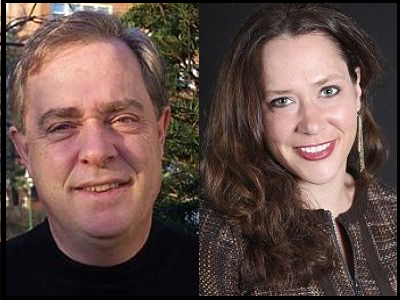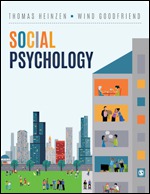Textbook Authorship: The Joys of a Crazy Undertaking
“Writing a textbook,” says Tom Heinzen, “is a foolish idea.” It’s an enormous undertaking and the rewards a few. But there are some rewards, and Heinzen and Wind Goodfriend, the authors of the new textbook Social Psychology, are reaping one of them: their book received a Most Promising New Textbook Award from the Textbook & Academic Authors Association, or TAA.
The TAA, which meets this week in Philadelphia, honored 31 textbooks this year in three categories: Most Promising, the William Holmes McGuffey Longevity Award, and the Textbook Excellence Award. Nominations for the awards are made by publishers or authors.
Heinzen and Goodfriend’s 632-page book, published by Social Science Space-parent SAGE Publishing, serves as introduction to social psychology, both the field’s history and its application. The latter is often achieved through storytelling, drawing on a large number of case studies (The book also has a case studies companion volume and an interactive e-book version).
Heinzen is professor of psychology at William Paterson University of New Jersey, where he founded the university’s Psychology Club, established an undergraduate research conference, and received various teaching honors. In addition to books and articles, he writes plays that help teach general psychology and statistics.
Goodfriend is a professor of psychology and assistant dean of graduate programs at Iowa’s Buena Vista University, where she is director of the Trauma Advocacy Program. She is also principal investigator for the Institute for the Prevention of Relationship Violence. She too has won multiple teaching awards, having been Buena Vista’s “Faculty of the Year” three times having won the Wythe Award, a teaching honor that comes with a sabbatical and $30,000.
We asked the co-authors some questions about their field and the process of coming up with an exceptional textbook.
Could you tell us a little bit about your respective academic journeys?

WIND GOODFRIEND: As a child, I was very strange – I didn’t fit in and had no friends. The silver lining was that I used my isolation to read, and I fell in love with books and ideas. My identity became someone who valued unconventionality and curiosity about how humans interact with each other. That meant that a career in academia studying social psychology was the perfect path for me. Social psychology asks the same questions I asked myself as a child – Why do people make certain choices? Why are some people cooperative and others aggressive? How do we choose our friends and lovers? – but approached them from a scientific perspective.
TOM HEINZEN: I dropped out of college when I was 18 – I didn’t make it through my first year. I restarted at a rural community college when I was 29, married, and with two children. I had been born in New York City and raised in the suburbs – and with many privileges. But going to Highland Community College in the middle of the cornfields in northwestern Illinois was how I regained some control over my life. So I appreciate the raw power of education.
How did those journeys lead you to write a textbook? What was the original reason you wrote the book?
WIND: I admired authors from an early age, and I saw the potential in sharing ideas with the next generation of scholars. Writing a textbook became a dream of mine, but I didn’t know how to fulfill it. Fortunately, Tom reached out to me as a potential co-author and mentor, and he has been wonderful. He and I shared a vision for what we thought would be the ideal social psychology textbook, and it was a pleasure to learn from his experience. Luckily, working with Tom helped me achieve the dream of writing a successful textbook, and he became a great friend.
TOM: I know how social psychology in particular helped me understand why momentary decisions had lasting effects, why social forces sustained both my good and my bad decisions, and what practical opportunities are still pulling me into an adventurous future.
How is this book different from other titles in the field?
TOM: I was once given an instructor’s version of a textbook written by a famous psychologist. It had two place-holding ribbons, gold and purple, like those you see on old religious texts, dictionaries, or encyclopedias. I was still thinking about those ribbons 20 years later when I realized how wrong they were. Psychology’s insights don’t descend from some all-knowing, comprehensive authority. Our uncertain insights bubble up as flawed humans struggle to think scientifically about human behavior. That is why Wind and I tell psychology’s unfolding story using plain language, a conversational style, and a caring teacher’s awareness of what students are experiencing.
WIND: Our vision was to write a textbook that students actually wanted to read. We wanted students to find the language accessible, the material interesting, and the content immediately applicable to their own lives. We hope students will look forward to their homework when they need to read the next chapter, and maybe even keep the book as a lifelong reference.
What’s the most important lesson you learned in writing this textbook?
TOM: We learned how our rewriting benefits students. We love rewriting because we (a) love the material, and (b) have turned rewriting into a game. Play the rewriting game with us. Here are the rules: every paragraph is a coherent idea. Rewrite that idea using the fewest possible words without losing any meaning – while making the idea more memorable. Rewriting is fun when you already love the ideas you are writing about.
WIND: If I think the paragraph is boring, it’s not good enough. Just meeting deadlines and seeing my name on a book cover doesn’t mean anything if I’m not proud of it and if students don’t really love social psychology by the last chapter. My mission is to convert readers to passionate psychological scientists – but I’ll be satisfied with people who are educated about real, modern social psychological issues today and how to understand those issues from a scientific perspective.
Outside experts have now spoken as to whether your book is a success. But from your vantage point, why is this book a success?
TOM: Part of our success is due to what cognitive psychologists have known all along: the importance of story. For example, our sense of story (Wind has been an actress, Tom a playwright) helped us recognize that the plot of social psychology’s story had already moved into behavior economics. The importance of story also sent us deeper into PsycINFO to look for first references, the earliest thought leaders, and the great ideas hiding behind unfamiliar language. These are some of the mundane differences that distinguish this book.
WIND: Last semester, I got to use the book in a class of real students. They talked with me about each chapter throughout the semester. I was expecting a lot of questions about the material itself – misunderstandings, clarifications, and so on. Instead, the questions I got were about applications of the material, what the next step would be in studying each topic, or whether the results of studies generalized to other people or to modern times. My students didn’t just want to learn the material and pass the test; they actually started to care. That’s a success.
While receiving an excellence award is certainly an honor, what sort of actionable information does being recognized by TAA provide you?
TOM: Writing a textbook is a foolish idea. It requires committing thousands of hours to an uncertain outcome that may never occur and is unlikely to produce any external rewards. If you don’t have occasional doubts, then you’re not being real. So, recognition from TAA peers is – at the least – a mild affirmation that you are not clinically crazy. That’s comforting and even encouraging. But given the principle of opportunity cost, it’s still a foolish idea. On the positive side, you gain a new batch of equally crazy friends.























































































